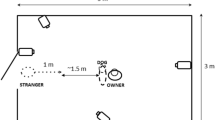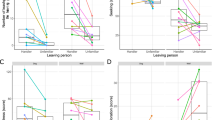Abstract
Social referencing is the seeking of information from another individual to form one’s own understanding and guide action. In this study, adult dogs were tested in a social referencing paradigm involving their owner and a potentially scary object. Dogs received either a positive or negative message from the owner. The aim was to evaluate the presence of referential looking to the owner, behavioural regulation based on the owner’s (vocal and facial) emotional message and observational conditioning following the owner’s actions towards the object. Most dogs (83%) looked referentially to the owner after looking at the strange object, thus they appear to seek information about the environment from the human, but little differences were found between dogs in the positive and negative groups as regards behavioural regulation: possible explanations for this are discussed. Finally, a strong effect of observational conditioning was found with dogs in the positive group moving closer to the fan and dogs in the negative group moving away, both mirroring their owner’s behaviour. Results are discussed in relation to studies on human–dog communication, attachment and social learning.




Similar content being viewed by others
References
Baldwin DA, Moses LJ (1996) The ontogeny of social information gathering. Child Dev 67:1915–1939
Bard K (1991) Distribution of attachment classifications in nursery chimpanzees. Am J Primatol 24:88
Bates E, Camaioni L, Volterra V (1975) The acquisition of performatives prior to speech. Merrill Palmer Q 21:205–224
Call J, Tomasello M (1996) The effect of human on the cognitive development of apes. In: Russon AE, Bard KA, Parker ST (eds) Reaching into thought: the minds of the great apes. Cambridge University Press, Cambridge, pp 371–402
Call J, Braüer J, Kaminski J, Tomasello M (2003) Domestic dogs (Canis familiaris) are sensitive to the attentional state of humans. J Comp Psychol 117:257–263
Carpenter M, Tomasello M (1995) Joint attention and imitative learning in children, chimpanzees and enculturated chimpanzees. Soc Dev 4:217–237
Clyman RB, Emde RN (1986) Social referencing and social looking among twelve-old infants. Affect Devel Infancy 74–94 Nordwood
Davis SJM, Valla FR (1978) Evidence for domestication of the dog 12, 000 years ago in the Batufian of Israel. Nature 276:608–610
de Rosnay M, Cooper PJ, Tsigaras N, Murray L (2006) Transmission of social anxiety from mother to infant: an experimental study using a social referencing paradigm. Behav Res Ther Engl 44:1164–1165
Deputte BL, Doll A (2011) Do dogs understand human facial expressions? J Vet Behav 6:78–79
Feinman S (1982) Social referencing in infancy. Merrill-Palmer Q J Dev Psychol 28:445–470
Feiring C, Lewis M, Starr MD (1984) In direct effects and infants’ reaction to strangers. Dev Psychol 20:485–491
Franco F, Butterworth G (1996) Pointing and social awareness: declaring and requesting in the second year. J Child Lang 23:307–336
Furlong EE, Boose KJ, Boysen ST (2008) Raking it in: the impact of enculturation on chimpanzee tool use. Anim Cogn 11:83–97
Gásci M, Miklósi A, Varga O, Topál J, Csányi V (2004) Are readers of our face readers of our minds? Dogs (Canis familiaris) show situation-dependent recognition of human’s attention. Anim Cogn 7:144–153
Gásci M, Gyoöri B, Virányi Z, Kubinyi E, Range F, Belènyi B, Miklósi A (2010) Explaining dog wolf differences in utilizing human pointing gesture: selection for synergistic shifts in the development of some social skills. Plos One 4:6584–6590
Gaunet F (2008) How do guide dogs of blind owners and pet dogs of sighted owners (Canis familiaris) ask their owners for food? Anim Cogn 11:475–483
Gaunet F (2010) How do guide dogs and pet dogs (Canis familiaris) ask their owners for their toy and for playing? Anim Cogn 13:311–323
Gunnar M, Stone C (1984) The effects of positive maternal affect on infant responses to peasant, ambiguous, and fear-provoking toys. Child Dev 55:1231–1236
Hare B, Call J, Tomasello M (1998) Communication of food location between human and dog (Canis familiaris). Evol Commun 2:137–159
Hare B, Brown M, Williamson C, Tomasello M (2002) The domestication of social cognition in dogs. Science 298:1634–1636
Hoehl S, Wiese L, Striano T (2008) Young infants’ neural processing of objects is affected by eye gaze direction and emotional expression. PLoS One 3:e2389
Hornik R, Risenhoover N, Gunnar M (1987) The effects of maternal positive, neutral and negative affective communication on infant responses to new toys. Child Dev 58:937–944
Horowitz A (2009) Disambiguating the “guilty look”: salient prompts to a familiar dog behaviour. Behav Processes 81:447–452
Itakura S (1995) Snakes as agents of evolutionary change in primate brains. J Hum Evol 51:44–48
Kaminski J, Bräuer J, Call J, Tomasello M (2009) Domestic dogs are sensitive to a human’s perspective. Behav 146:979–988
Kim G, Walden TA, Knieps LJ (2010) Impact and characteristics of positive and fearful emotional messages during infant social referencing. Infant Behav Dev 33:189–195
Klinnert MD, Campos JJ, Emde RN, Sorce JF (1983) Emotions as behaviour regulators Social referencing in infancy. In: Kellerman H, Plutchik R (eds) The emotions, vol 2. Academic Press, New York, pp 57–59
Kubinyi E, Topál J, Miklósi A, Csányi V (2003) Dogs (Canis familiaris) learn from their owners via observation in a manipulation task. J Comp Psychol 117:156–165
Liszkowski U, Carpenter M, Henning A, Striano T, Tomasello M (2004) Twelve-month-olds point to share attention and interest. Dev Sci 7:297–307
Marshall-Pescini S, Passalacqua C, Barnard S, Valsecchi P, Prato-Previde E (2009) Agility and search and rescue training differently affects pet dogs’ behaviour in socio-cognitive tasks. Behav Processes 81:416–422
Marshall-Pescini S, Passalacqua C, Valsecchi P, Prato-Previde E (2010) Comment on: “differential sensitivity to human communication in dogs, wolves, and human infants. Science 329:142
Miklósi A, Polgárdi TopálJ, Csányi V (2000) Intentional behaviour in dog-human communication: an experimental analysis of “showing” behaviour in the dog. Anim Cogn 3:159–166
Miklósi A, Kubinyi E, Topál J, Gácsi M, Virányi Z, Csányi V (2003) A simple reason for a big difference: wolves do not look back at humans, but dogs do. Curr Biol 13:763–766
Miklósi A, Pongrácz P, Lakatos G, Topál J, Csányi V (2005) A comparative study of the use of visual communicative signals in interaction between dogs (Canis familiaris) and humans and cats (Felis catus) and humans. J Comp Psychol 119:179–186
Miller HC, Rayburn-Reeves R, Zentall T (2009) What do dogs know about hidden object? Behav Processes 81:439–446
Mitchell RW (2001) Americans’ talk to dogs during play: similarities and differences with talk to infants. Res Lang Soc Interact 34:182–210
Mitchell RW (2004) Controlling the dog, pretending to have a conversation, or just being friendly? Influence of sex and familiarity on Americans’ talk to dogs during play. Interact Stud 5:99–129
Morton E (1977) On the occurrence and significance of motivation-structural rules in some bird and mammal sounds. Am Nat 111:981
Mumme DL, Fernald A, Herrera C (1966) Infants’ responses to facial and vocal emotional signals in a social referencing paradigm. Child Dev 67:3219–3237
Nagasawa M, Murai K, Mogi K, Kikusui T (2011) Dogs can discriminate smiling faces from blank expression. Anim Cogn. doi:10.1007/s10071-011-0386-5
Palmer R, Custance D (2008) A counterbalanced version of Ainsworth’s strange situation procedure reveals secure-base effects in dog-human relationship. Appl Anim Behav Sci 109:306–319
Pongrácz P, Miklósi A, Timar-Geng K, Csányi V (2003) Preference for copying unambiguous demonstrations in dogs (Canis familiaris). J Comp Psychol 117:337–343
Pongrácz P, Miklósi A, Timar-Geng K, Csányi V (2004) Verbal attention getting as a key factor in social learning between dog (Canis familiaris) and human. J Comp Psychol 118:375–383
Prato-Previde E, Custance DM, Spiezio C, Sabatini F (2003) Is the dog-human relationship an attachment bond? An observational study using Ainsworth’s strange situation. Behav 140:225–249
Prato-Previde E, Fallani G, Valsecchi P (2006) Gender differences in owners interacting with pet dogs: an observational study. Ethology 112:64–73
Prato-Previde E, Marshall-Pescini S, Valsecchi P (2008) Is your choice my choice? The owners’ effect on pet dogs’ (Canis lupus familiaris) performance in a food choice task. Anim Cogn 11:167–174
Racca A, Amadei E, Ligout S, Guo K, Meints K, Mills D (2010) Discrimination of human and dog faces and inversion responses in domestic dogs (Canis familiaris). Anim Cogn 13:525–533
Reid PJ (2009) Adapting to the human world: dogs responsiveness to our social cues. Behav Processes 80:325–333
Roberts SG, McComb K, Ruffman T (2008) An experimental investigation of referential looking in free-ranging Barbary macaques (Macaca sylvanus). J Comp Psychol 122:94–99
Rosen WD, Adamson LB, Bakeman L (1992) An experimental investigation of infant social referencing: mothers message and gender differences. Dev Psychol 28:1172–1178
Ruffman T, Morris-Trainor Z (2011) Do dogs understand human emotional expressions? J Vet Behav 6:97–98
Russell CL, Bard KA, Adamson LB (1997) Social referencing by young chimpanzees (Pan troglodytes). J Comp Psychol 111:185–193
Sorce JF, Emde RN, Campos J, Klinnert M (1985) Maternal emotional signaling: its effect on the visual cliff behaviour of 1 year olds. Dev Psychol 21:195–200
Stenberg G, Hagekull B (1997) Social referencing and mood modification in 1 year olds. Infant Behav Dev 20:209–217
Tomonaga M, Tanaka M, Matsuzawa T, Myowa-Yamakoshi M, Kosugi D, Mizuno Y, Okamoto S, Yamaguche MK, Bard KA (2004) Development of social cognition in infant chimpanzees (Pan troglodytes): Face recognition, smiling, gaze and the lack of triadic interactions. Jpn Psychol Res 46:227–235
Topál J, Miklósi A, Csányi V, Dóka A (1998) Attachment behavior in dogs (Canis familiaris): a new application of Ainsworth’s (1969) strange situation test. J Comp Psychol 112:219–229
Topál J, Gásci M, Miklósi A, Virányi Z, Kubinyi E, Csányi V (2005) Attachment to humans: a comparative study on hand-reared wolves and differently socialized dog puppies. Anim Behav 70:1367–1375
Udell MAR, Giglio RF, Wynne CDL (2008) Domestic dogs (Canis familiaris) use human gestures but not non human tokens to find hidden food. J Comp Psychol 122:84–93
Vaish A, Striano T (2004) Is visual reference necessary? Contributions of facial versus vocal cues in 12-month-olds’ social referencing behavior. Dev Sci 7:261–269
Vas J, Topál J, Gácsi M, Miklósi A, Csányi V (2005) A friend or an enemy? Dogs’ reaction to an unfamiliar person showing cues of threat and friendliness at different times. App Anim Behav Sci 94:99–115
Virányi Z, Topál J, Gácsi M, Miklósi A, Csányi V (2004) Dogs respond appropriately to cues of humans’ attentional focus. Behav Processes 31:161–172
Virányi Z, Gácsi M, Kubinyi E, Topál J, Belényi B, Ujfalussy D, Miklósi A (2008) Comprehension of human pointing gestures in young human-reared wolves (Canis lupus) and dogs (Canis familiaris). Anim Cogn 11:373–387
Walden TA, Ogan TA (1988) The development of social referencing. Child Dev 59:1230–1240
Whiten A, Horner V, Litchfield CA, Marshall-Pescini S (2004) How do apes ape? Learn Behav 32:36–52
Zentall TR (2006) Imitation: definitions, evidence and mechanisms. Anim Cogn 9:335–353
Zumbahlen M, Crawley A (1996) Infants’ early referential behavior in prohibition contexts: the emergence of social referencing. In: RA Thompson (ed) Taking perspective on social referencing: new viewpoints symposium conducted at the international conference of infant studies, Providence
Acknowledgments
This research was supported by a PhD and post-doctoral grant from Milan University to Isabella Merola and Sarah Marshall-Pescini. A special thanks to Lara Tomaleo and Chiara Passalacqua for their invaluable help in data collection and scoring and to referees and Paola Valsecchi for insightful comments on the manuscript. Finally, we would like to thank all the owners and dogs that participated as volunteers. This research complies with the current Italian laws on animal welfare.
Author information
Authors and Affiliations
Corresponding author
Appendix
Appendix
Azawakh 1, Dachshund 1, Beagle 3, Bichon Frise 2, Border Collie 1, Boxer 2, Bulldog 1, Cau de agua 1, Cocker Spaniel 2, Dalmatian 1, Doberman 2, Argentinean Dogo 2, Epagneul Breton 3, Golden Retriever 8, Siberian Husky 2, Labrador Retriever 2, Lagotto 1, German Shepherd 2, Setter Irish 1, Shiba Inu 1, Shitzu 1, Schnauzer 1, Terranova 1, West Highland Terrier 1.
Rights and permissions
About this article
Cite this article
Merola, I., Prato-Previde, E. & Marshall-Pescini, S. Social referencing in dog-owner dyads?. Anim Cogn 15, 175–185 (2012). https://doi.org/10.1007/s10071-011-0443-0
Received:
Revised:
Accepted:
Published:
Issue Date:
DOI: https://doi.org/10.1007/s10071-011-0443-0




